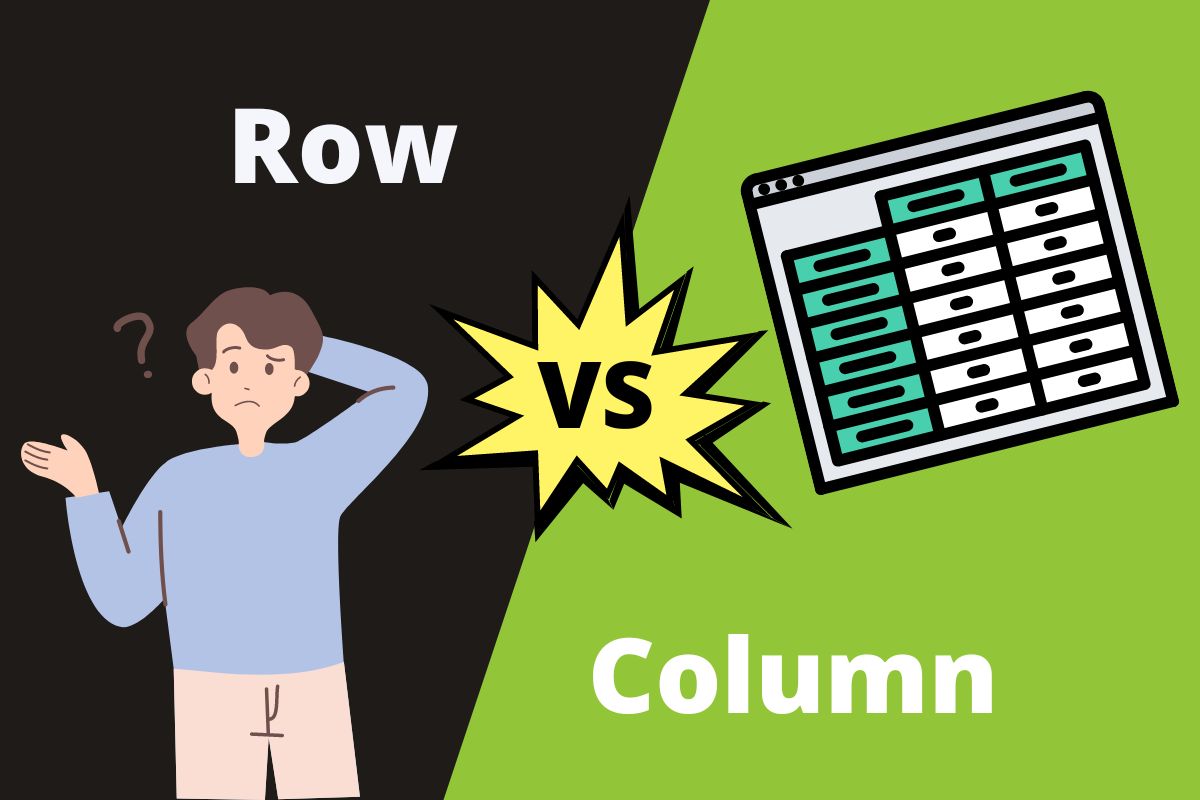The main difference between a row and a column is how data is arranged. A row has a horizontal arrangement of data, while a column has a vertical arrangement of data.
Rows and columns are important when when dealing with bulk data. This is because the main purpose of both rows and columns is to segregate groups, categories, and other items for a more straightforward analysis.
Whether you’re using Microsoft Excel or Google, knowing the difference between row and column will help you better organize your next data set.
Table of Contents
Difference Between Row and Column
| Row | vs | Column |
| A stub that is present at the extreme left of the table | Represented By | A caption is present at the extreme top of the table |
| Left to right in a row | Data Arrangement | Top to bottom in a column |
| Records in Database Management, Horizontal Arrays in a matrix. | Also Known As | Fields in Database Management, Vertical Arrays in a matrix. |
| Total rows are shown at the end of the selected row | Displayed As | Total columns are shown at the bottom of the selected column |
| Data in the row includes information that describes a single entity | Types Of Information | Data in the column represents a field of information all the entities possess |
What is a Row?
The term row is defined by a series of data placed horizontally from the left part of the table to the correct position.
This data can be anything from numbers to objects and names in Google Sheets or Excel spreadsheets. A spreadsheet is a computer program for personal computers. It finds applications in computation, organization, analysis, and storage of data in tabular form.
In other words, objects or data are arranged face-to-face in a row beside each other in a straight line.
The maximum number of rows a worksheet can contain is 1,048,576. Horizontal arrays are called rows in the “matrix.”
Row Examples
Here are a few common examples of a row.
- The seats in the school are arranged in one row after another
- The seats in a hall are organized in rows
- A flock of ducklings swims together in a row
- The books in the library are arranged in a row on the shelves
- A row of houses alongside the river
- Students are standing in the front row of the shop
What is a Column?
The term column is the vertical arrangement of cells in a spreadsheet chart or table. The arrangement can include figures, facts, words, data, or objects. The data in the column goes from top to bottom in continuity.
A worksheet can have a maximum of 16,384 columns in total. In a table, columns are divided from each other by lines.
Vertical arrays in a matrix are called columns.
Column Examples
Here are a few examples of a column.
- Arrangement of weekly recipe items in a column
- The vertical movement of an elevator shaft in an apartment
- A set of military vehicles that goes one behind the other is said to be in column
- The articles in the newspaper are broken into columns
- Flames from the chimney create a column of smoke
- Pillar in the front of a building
Rows and columns are an essential part of a table to arrange data systematically. The terms row and column are very common yet often used interchangeably.
Differences Between Row and Column
Representation
Rows are represented by a stub at the extreme left of the table. However, the column is represented by the caption at the extreme topmost of the table.
Data Arrangement
Data is arranged from left to right in a row. In contrast, data is organized from top to bottom in a column.
Also Known As
Rows are also known as “Records” in Database Management System (DBMS) and “Horizontal Arrays” in a matrix. Conversely, columns are known as “Fields” in Database Management System and “Vertical Arrays” in a matrix.
Displayed As
Total rows or the sum of rows are shown at the end of the selected row. In contrast, the total or the sum of columns is shown at the bottom of the selected column.
Type of Information
The data in the row includes information that describes a single entity. In contrast, the data in the column represents a field of information all the entities possess.
Row vs Column: Understanding the Differences
The usage of the terms row and column might be confusing. However, they’re an integral part of a spreadsheet, table, and chart. They find their uses in metrics to distinguish categories, classifications, and types.



